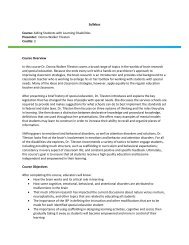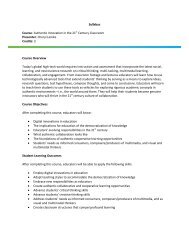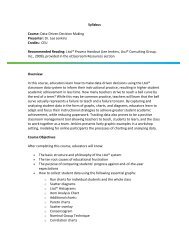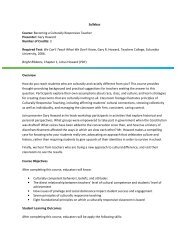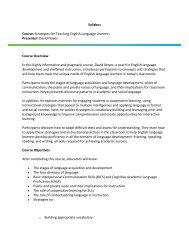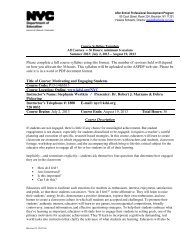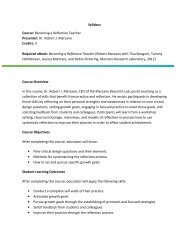Kay Burke Required eBook: Balanced Assessment
Kay Burke Required eBook: Balanced Assessment
Kay Burke Required eBook: Balanced Assessment
You also want an ePaper? Increase the reach of your titles
YUMPU automatically turns print PDFs into web optimized ePapers that Google loves.
Syllabus<br />
Course: <strong>Assessment</strong> and the Common Core State Standards<br />
Presenter: <strong>Kay</strong> <strong>Burke</strong><br />
<strong>Required</strong> <strong>eBook</strong>: <strong>Balanced</strong> <strong>Assessment</strong>: From Formative to Summative (<strong>Kay</strong> <strong>Burke</strong>, Solution<br />
Tree Press, 2010)<br />
Course Overview<br />
In this practical course, Dr. <strong>Kay</strong> <strong>Burke</strong> shows how to create and use assessment tools that<br />
improve instruction (formative assessments) as well as gauge its success (summative<br />
assessments), and how to arrive at an effective balance of the two.<br />
Dr. <strong>Burke</strong> demonstrates how to plan instruction as part of a collaborative team, repacking the<br />
Common Core standards and sharing meaningful instructional objectives with students. She<br />
provides examples of performance tasks that will motivate students in every grade.<br />
Teachers taking this course will get a first-hand look at checklists, rubrics, and informal<br />
assessments in use in actual classrooms -- from second-graders studying shapes to high-school<br />
juniors investigating global human rights abuses. Educators will come away with tools and<br />
strategies that they can use immediately, making balanced assessment an integral part of their<br />
own instruction.<br />
Course Objectives<br />
After completing this course, educators will know:<br />
How to distinguish between formative assessment, summative assessment, and<br />
evaluation<br />
The importance of creating a balanced assessment model that both improves and<br />
proves learning<br />
Student Learning Outcomes<br />
After completing this course, educators will be able to:<br />
Identify power standards<br />
Repack the Common Core State Standards as part of a collaborative team<br />
Collaborate with grade-level or subject-area teams to create common assessments<br />
Create performance tasks, checklists, and rubrics appropriate to their grade levels or<br />
subject areas
Use formal and informal assessment tools to improve instruction and evaluate mastery<br />
of the standards<br />
Unit 1: Standards-Based Instruction and <strong>Assessment</strong><br />
In this unit, Dr. <strong>Burke</strong> introduces the Common Core State Standards, describing the steps<br />
needed to “repack” the standards in a teacher- and student-friendly way. She provides concrete<br />
examples from a variety of disciplines, and workshop participants demonstrate the process.<br />
Unit Objectives<br />
After completing this unit, educators will know:<br />
How to identify power standards<br />
Strategies for repacking the Common Core State Standards in order to guide instruction<br />
Student Learning Outcomes<br />
After completing this unit, educators will be able to:<br />
Use a six-step process to repack the standards as part of a collaborative team<br />
Unit 2: <strong>Balanced</strong> <strong>Assessment</strong><br />
In this unit, Dr. <strong>Burke</strong> defines formative assessment, summative assessment, and evaluation,<br />
with plenty of examples of each. Workshop participants discuss the uses of assessment in their<br />
own practices.<br />
Unit Objectives<br />
After completing this unit, educators will know:<br />
The definition and importance of formative assessment and feedback<br />
The characteristics of formative and summative assessment<br />
The difference between assessment and evaluation<br />
Student Learning Outcomes<br />
After completing this unit, educators will be able to:
Explain the balanced assessment model<br />
Unit 3: Common <strong>Assessment</strong>s<br />
Here, <strong>Kay</strong> <strong>Burke</strong> explores the role of the professional learning community in creating common<br />
assessments. She walks participants through an eight-step Common <strong>Assessment</strong> Cycle, from<br />
identifying power standards through final course grades. Educators explain how they<br />
collaborate with their peers to create common assessments.<br />
Unit Objectives<br />
After completing this unit, educators will know:<br />
The reasons for creating common assessments<br />
Student Learning Outcomes<br />
After completing this unit, educators will be able to:<br />
Collaborate within grade-level or subject-area teams to create common assessments<br />
Unit 4: Performance Tasks for Authentic Learning<br />
In this unit, Dr. <strong>Burke</strong> describes the features of performance tasks, as well as the benefits of<br />
using them. Teams of social studies and English Language Arts teachers are given fifteen<br />
minutes to come up with a performance task for each subject, with inspiring results. (Dr. <strong>Burke</strong><br />
says teachers can plan performance tasks today and use them in the classroom tomorrow, and<br />
we’ll see the payoff later in the course.)<br />
Unit Objectives<br />
After completing this unit, educators will know:<br />
Why performance tasks are an important part of a teacher’s repertoire<br />
When and how to use performance tasks to motivate students<br />
The role of checklists and rubrics in assessing work on performance tasks<br />
Student Learning Outcomes<br />
After completing this unit, educators will be able to:
Design performance tasks appropriate to their grade levels and subject areas<br />
Unit 5: Checklists for Learning<br />
<strong>Kay</strong> <strong>Burke</strong> says, “Rubrics are our friends; checklists are our best friends.” In this unit, she<br />
explores the use of the lesser-known tool, the checklist, to guide students’ work, promote selfmonitoring,<br />
and serve as a formative assessment for teachers and students alike. Teachers<br />
discuss the benefits of checklists and how to introduce them to a class. We watch the process<br />
unfold in several classrooms - from identifying and describing shapes in grade 2 to identifying<br />
and describing character traits in grade 8.<br />
Unit Objectives<br />
After completing this unit, educators will know:<br />
How to create checklists that serve as teaching guides<br />
The components of a quality checklist for students<br />
How to embed the language of the standards in all checklists<br />
How to use checklists to help struggling students<br />
Student Learning Outcomes<br />
After completing this unit, educators will be able to:<br />
Create checklists appropriate to their grade levels and subject areas<br />
Unit 6: Rubrics<br />
In this unit, Dr. <strong>Burke</strong> discusses the ins and outs of rubrics: how to convert checklists to rubrics,<br />
how to weight items based on their relative importance, and how to write good descriptors<br />
(including those rigorous enough to merit an “exceeds the standards” rating). We see the<br />
launch of a performance task in a high school social studies class, complete with checklists and<br />
rubrics. And a trio of high school students explains the value of performance tasks, checklists,<br />
and rubrics in their current class and beyond.<br />
Unit Objectives<br />
After completing this unit, educators will know:<br />
How to convert checklists to rubrics
How to create descriptors of quality work to guide students to master the standards<br />
Student Learning Outcomes<br />
After completing this unit, educators will be able to:<br />
Design rubrics appropriate to their grade levels and subject areas<br />
Unit 7: Formative <strong>Assessment</strong> Tools<br />
Not every standard requires a carefully-created performance task and accompanying<br />
assessments. But daily monitoring of student progress is key to learning success. In this unit, Dr.<br />
<strong>Burke</strong> shares an assortment of graphic organizers and metacognitive strategies (thinking about<br />
our own thinking) that will help teachers assess student understanding in “real time and real<br />
fast.”<br />
Unit Objectives<br />
After completing this unit, educators will know:<br />
A repertoire of easily implemented formative assessment tools<br />
How to use instructional strategies as assessment strategies<br />
The role of metacognition in formative assessment<br />
Student Learning Outcomes<br />
After completing this unit, educators will be able to:<br />
Select and use a variety of informal assessment strategies (for example, Venn Diagrams,<br />
Human Rubrics, Learning Logs, and Agree/Disagree Charts) as well as strategies for<br />
summarizing learning at the end of a lesson<br />
Unit 8: Summative <strong>Assessment</strong> and Evaluation<br />
Here, <strong>Kay</strong> <strong>Burke</strong> concludes the course with summative assessment and evaluation. How much<br />
weight should be given to formative and summative assessments Should students be given<br />
zeroes Should they be given the opportunity to re-do work In this unit, Dr. <strong>Burke</strong> poses the<br />
questions districts should be considering in establishing grading policies. Teachers and<br />
administrators weigh in.
Unit Objectives<br />
After completing this unit, educators will know:<br />
The relationship between formative and summative assessment<br />
Student Learning Outcomes<br />
After completing this unit, educators will be able to:<br />
Use multiple formative and summative assessment tools in order to arrive at a final<br />
evaluation<br />
Presenter Bio<br />
<strong>Kay</strong> <strong>Burke</strong> works with her colleagues at <strong>Kay</strong> <strong>Burke</strong> & Associates to present professional<br />
development workshops for teachers and administrators on standards-based teaching and<br />
learning, formative assessment, and classroom management. She received her undergraduate<br />
degree from Florida Atlantic University, her master’s degree from the University of Central<br />
Florida, her educational specialist degree from Emory University, her PhD from Georgia State<br />
University, and her administration certification from the University of Georgia.<br />
<strong>Kay</strong> served as award-winning English teacher, department chairperson, dean of students,<br />
mentor, and administrator in Florida and Georgia for twenty years. She also was the director of<br />
the field-based master’s program sponsored by the International Renewal Institute<br />
(IRI/Skylight) and Saint Xavier University in Illinois. Since 1990, <strong>Kay</strong> has designed and conducted<br />
professional development workshops and presented at conferences of the National Staff<br />
Development Council, the Association for Supervision and Curriculum Development, the<br />
National Association of Secondary School Principals, the National Association of Elementary<br />
School Principals, Solution Tree, and the International Reading Association, as well as<br />
international conferences in Canada and Australia.<br />
<strong>Kay</strong> has written or edited thirteen books on standards-based learning, formative assessment,<br />
classroom management, student and professional portfolios, and mentoring. One of these,<br />
From Standards to Rubrics in Six Steps: Tools for Assessing Student Learning, K-8, was a finalist<br />
for the Distinguished Achievement Award from the Association of Educational Publishers in<br />
2007.<br />
Methods of Instruction:<br />
Videos (presentations consisting of lecture, interviews, and classroom footage)
Reflection questions (open-ended questions at intervals throughout the videos where<br />
educators are asked to reflect on the course content, their own practice, and their<br />
intentions for their practice)<br />
Quizzes (selected-response quizzes to assess understanding of the video presentations)<br />
All steps listed under each topic must be completed to receive credit for the course. No<br />
partial credit will be given.<br />
Plagiarism Policy<br />
KDS recognizes plagiarism as a serious academic offense. Plagiarism is the dishonest passing off<br />
of someone else’s work as one’s own and includes failing to cite sources for others’ ideas,<br />
copying material from books or the Internet, and handing in work written by someone other<br />
than the participant. Plagiarism will result in a failing grade and may have additional<br />
consequences. For more information about plagiarism and guidelines for appropriate citation,<br />
consult plagiarism.org.<br />
KDS Rubric for Pass/Fail Option: CEU<br />
Passing Requirements:<br />
70 points or more<br />
No “unsatisfactory” in either category<br />
Quizzes<br />
Reflection questions<br />
40% of total grade<br />
60% of total grade
Component Unsatisfactory Basic Proficient Distinguished<br />
Quizzes<br />
(16 points)<br />
(24 points)<br />
(32 points)<br />
(40 points)<br />
Quizzes:<br />
Quizzes:<br />
Quizzes:<br />
Quizzes:<br />
0 - 40% correct<br />
60% correct<br />
80% correct<br />
100% correct<br />
Reflection<br />
questions<br />
(30 points)<br />
Reflection<br />
questions:<br />
(40 points)<br />
Reflection<br />
questions:<br />
(50 points)<br />
Reflection questions:<br />
(60 points)<br />
Reflection questions:<br />
-Participant<br />
includes no<br />
content from<br />
the course in<br />
his or her<br />
responses<br />
-Participant<br />
does not<br />
address the<br />
questions<br />
posed<br />
-Participant<br />
includes some<br />
content from the<br />
course, usually<br />
appropriate, in<br />
his or her<br />
responses<br />
-Participant<br />
answers the<br />
questions<br />
directly, not<br />
always fully<br />
-Participant includes<br />
appropriate content<br />
from the course in<br />
his or her responses<br />
-Participant makes<br />
thoughtful comments<br />
in direct response to<br />
the questions<br />
-Participant provides<br />
rich detail from the<br />
content of the course<br />
in his or her responses<br />
-Participant makes his<br />
or her responses to the<br />
questions personally<br />
meaningful




